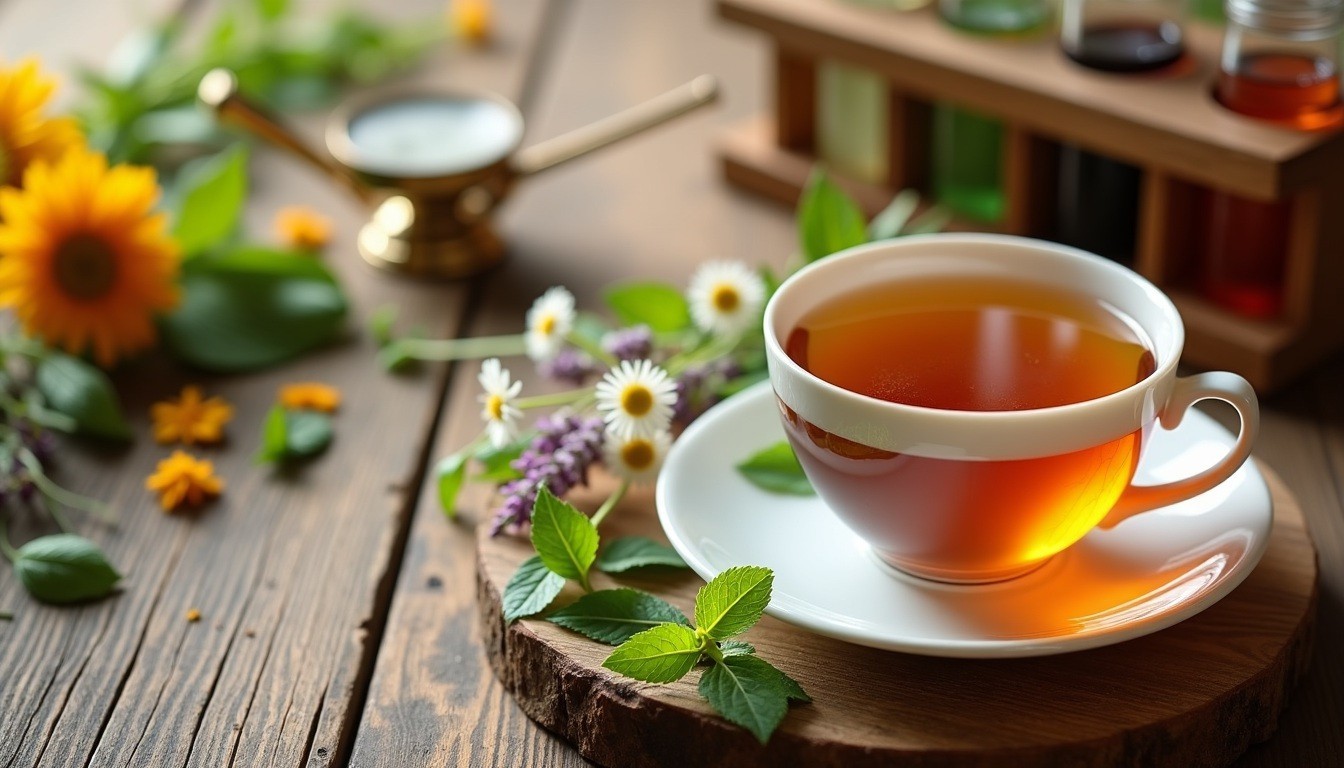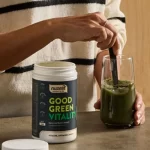

Herbal tea offers benefits that go way beyond a warm, soothing drink. Modern scientific research now supports what traditional medicine has known for centuries. These natural beverages have helped people deal with everyday issues from sleep problems to digestive issues.
Recent studies paint a clear picture of these traditional benefits. People who drink herbal tea regularly face lower risks of strokes and heart attacks. Specific types like chamomile help older adults and new mothers sleep better. These caffeine-free drinks are rich in antioxidants that curb inflammation and fight free radicals. The risk of chronic diseases drops significantly.
British scientists’ detailed research explains how different herbal teas affect human health. Their work gives an explanation of the science behind these benefits. The evidence shows how each variety contributes to our overall well-being.
Britain’s trip through herbal tea research covers centuries. It started with ancient medicinal texts and grew into sophisticated scientific studies. British documented history of medicinal plants goes back to Anglo-Saxon times. Three most important texts emerged from the tenth century: the Old English Herbarium, Bald’s Leechbook, and ‘Lacnunga’ [1].
British early contribution to herbal medicine research showed systematic documentation. The Old English Herbarium listed 185 plants, and 140 had distinct Anglo- Saxon names [1]. The Welsh manuscript ‘Llyfr Coch Hergest’ (The Red Book of Hergest), written after 1382, kept valuable information about herbal remedies. A medical dynasty that lasted over 500 years compiled this knowledge [1].
The market has seen major changes in consumer priorities. Sales of fruit and herbal teabags jumped by 31% from £58m to £76m between 2012 and 2014 [2]. This growth has sparked more research interest to understand the health benefits of herbal teas.
British research now uses various scientific approaches to study herbal teas:
These advanced techniques help researchers analyse herbal teas’ chemical composition and therapeutic properties. A newer study, published in 2021, looked at 145 research publications and found 21 most important studies that focused on various health aspects [3].
Research keeps evolving. Scientists now study how herbal teas interact with human microbial flora. These studies look at how bioactive compounds in herbal teas might change microbial communities and affect overall health [5].
Scientists have found strong evidence that herbal tea offers significant health benefits. New research methods and various studies now validate what traditional medicine has known for centuries.
Clinical research shows remarkable results for multiple health conditions. People with pre-hypertensive and mild hypertensive conditions experienced lower blood pressure after drinking hibiscus tea [6]. Sleep quality improved when people drank chamomile tea, especially when you have older adults and postpartum women [5].
Research expresses how well ginger tea works for several conditions:
Scientists have discovered clear patterns in how herbal tea benefits our health. A complete review of clinical trials showed that people who regularly drank herbal tea (2-20g daily of plant ingredients) had better blood glucose control [7]. Studies also showed that drinking rose hip tea twice daily helped reduce body mass index and belly fat [5].
| Health Marker | Observed Effect |
| Blood Glucose | Significant reduction [7] |
| HDL Cholesterol | Notable increase [8] |
| Triglycerides | Substantial decrease [8] |
Meta-analyses provide strong statistical proof of herbal tea’s benefits. A newer study of 14 randomised controlled trials with 551 participants showed that herbal tea helped reduce:
Notwithstanding that, different types of tea work differently. To name just one example, passionflower tea improved sleep quality markers, though some results matched placebo effects [5]. Research continues to explore the best preparation methods and dosages.
Cancer-prevention research looks promising. Regular tea drinkers may face lower risks of prostate, lung, and colorectal cancer [9]. Women who regularly drank green tea had a 32% lower risk of pancreatic cancer, and this benefit increased with longer consumption [9].
Scientists have found that herbal teas contain powerful compounds that work through many biological pathways to boost health. Lab studies show these natural drinks have high healing potential through their unique molecular mechanisms.
Herbal teas’ remarkable health benefits come from their rich antioxidant content. These drinks contain various phytochemicals, including phenolic acids, flavonoids, tannins, vitamins, and terpenoids [10]. These compounds work through both primary and secondary antioxidant mechanisms [10].
Antioxidant Components in Herbal Tea:
| Compound Type | Primary Function |
| Phenolic Acids | Hydrogen donors |
| Flavonoids | Metal chelators |
| Tannins | Free radical scavengers |
| Terpenoids | Oxidation blockers |
Research shows that herbal teas have strong anti-inflammatory abilities. Green tea works better than black tea at fighting protein denaturation because it has more flavonoids [11]. These properties make herbal teas great for managing inflammatory conditions.
The anti-inflammatory action occurs through multiple pathways:
Without doubt, herbal teas shine brightest in their ability to prevent and manage chronic conditions. Studies show that people who drink these beverages regularly face lower risks of various diseases. People who drink three or more cups daily have a 21% lower risk of stroke compared to those who drink less than one cup [9].
The benefits cover many health conditions. Clinical studies show that hibiscus tea lowers blood pressure in pre-hypertensive and mildly hypertensive adults effectively [6]. The bioactive compounds in herbal teas work together to curb various chronic conditions through their antioxidant and anti-inflammatory properties.
New research reveals that herbal teas can improve glycemic profiles in people with Type 2 diabetes by a lot. They help improve both fasting blood glucose levels and HbA1c [12]. These teas contain polyphenolic compounds with strong antiviral, anti-oxidant, and anti-inflammatory properties, making them valuable for managing chronic diseases [13].
These findings match population studies that show regular tea drinkers have lower risks of heart diseases, certain cancers, and inflammatory conditions. The protective effects come from the unique mix of bioactive compounds that work together to support overall health [14].
Research has revealed the complex molecular mechanisms that make herbal teas good for human health. These natural drinks set off intricate signalling chains in cells that promote wellness and help curb disease.
Herbal tea’s healing effects work through several important cellular pathways. Studies show that tea polyphenols turn on autophagy through the mTOR pathway to help delay cellular stress [15]. Green tea compounds activate AMPK in liver cells and start a chain of protective mechanisms [1].
Notable cellular responses include:
A rich mix of bioactive ingredients creates these molecular benefits. Research shows herbal teas contain:
| Compound Type | Percentage in Tea |
| Polyphenols | ~90% |
| Amino acids | ~7% |
| Caffeine | ~3% |
EGCG makes up 50-80% of total polyphenols [1]. These bioactive compounds work together cooperatively. Catechins, flavonoids, and alkaloids each play unique roles in promoting health [16].
The way herbal tea compounds work depends largely on how well the body absorbs them. Studies show only 0.2–2% of consumed catechins reach human plasma[17]. This slow absorption actually helps create lasting beneficial effects. Key factors affecting absorption include:
Scientists have created innovative solutions to improve absorption. Nanoparticle-based delivery systems show promising results by helping the body absorb tea compounds better [18]. Encapsulation with materials like chitosan has substantially increased the permeability coefficient of beneficial compounds [18].
The molecular mechanisms keep working even after absorption. Tea polyphenols go through extensive metabolism by phase II enzymes, mainly in the small intestine and liver [18]. This metabolic process creates various conjugates, and about 80% of tea catechins in plasma appear in conjugated forms [17].
Scientists have found specific cellular targets. Green tea activates autophagy in HL-60 xenografts by increasing PI3 kinase activity [1]. The compounds also improve Nrf-2 mediated antioxidant mechanisms that protect the cardiovascular system [1].
These molecular interactions explain why people who drink herbal tea regularly get multiple health benefits. The compounds work through different pathways – AMPK activation, mTOR regulation, and improvement of cellular autophagy mechanisms [15]. This comprehensive approach helps explain the wide range of health benefits that come from drinking herbal tea regularly.
The difference between herbal tea types can help you discover their full potential health benefits. Getting a full picture of how these teas are prepared and processed shows their effect on therapeutic properties.
Pure herbal teas from a single herb deliver focused therapeutic effects with distinct flavour profiles [19]. Blended teas mix multiple herbs to create complex flavours and boost health benefits. Research shows that single-herb teas like chamomile target specific conditions. They work particularly well for improving sleep quality in older adults [5].
| Tea Type | Primary Benefits | Best For |
| Single Herb | Focused therapeutic effects | Specific health concerns |
| Blended | Multiple health benefits | Overall wellness |
| Spice-based | Warming properties | Digestive health |
The way herbs are processed determines their final therapeutic value. Studies reveal that different drying techniques change the concentration of active ingredients [20]. Oven-drying at 40°C increases triterpenoid levels and boosts antioxidant effects [20].
Research shows that oven-dried herbs at controlled temperatures have more consistent chemical composition [20]. This guides us toward more reliable therapeutic outcomes.
Proper preparation techniques determine how well herbal tea works. Hot tea infusion remains the traditional method we used to extract flavours and medicinal properties [21]. Water temperature and steeping time play crucial roles in extracting beneficial compounds.
Optimal preparation guidelines:
Decoction works better for tougher materials like roots and bark. This method uses one part dried herbs to ten parts water. You bring it to a boil and simmer uncovered [21]. Fresh herbs need less steeping time than dried ones [3].
Storage plays a key role in keeping tea quality high. Herbs need a cool place, and botanicals need more care than traditional teas [24]. Quality control shows that buying small quantities and restocking as needed helps preserve therapeutic properties [24].
Sun-infused preparations give you another option, especially during warm months. This gentle method creates mellower flavours with less bitterness than hot- water preparations [3]. It helps preserve delicate flavours and therapeutic properties.
Water quality makes a big difference in tea’s taste and therapeutic qualities [21]. The right preparation methods ensure you get the most beneficial compounds, which boost the tea’s health-promoting properties.
Herbal teas are great for your health, but you need to pay attention to safety to get the best results. New studies show why it’s important to know the right dose, how different herbs interact, and what makes a quality product.
The right dose of herbal tea makes a big difference in how well it works and how safe it is. Studies show most herbs are safe in food amounts, but medicinal doses need more careful attention [25].
| Tea Type | Daily Recommended Intake | Duration |
| General Herbal | 2-8 cups | Throughout day |
| Medicinal Blends | 1-3 cups | As prescribed |
| Therapeutic Doses | 2-20g dried herb | Under supervision |
You can drink up to 8 cups of caffeine-free herbal teas daily, but some types like liquorice need limits [26]. The right amount changes based on your health and personal factors.
Mixing herbal teas with regular medicines can cause problems. A newer study shows 42% of surgery patients took alternative medicines two weeks before their procedures [4].
These risks stand out:
St. John’s wort mixes badly with many medicines and often makes them less effective [27]. Strong green tea supplements can lower blood levels of certain medications, including cholesterol drugs and beta-blockers [27].
Good herbal tea needs detailed testing and standard procedures. Research shows that outside testing for metals, mould, pesticides, and harmful organisms is vital[4].
Quality control looks at:
Good storage makes a big difference in tea quality. Herbs stay potent for up to a year in airtight containers [25]. Ground herbs should be used within a few months to keep their healing properties.
Safety goes beyond making the tea. The California Department of Health Services found that 7% of Asian patent medicines had hidden drugs [4]. Many stores now need lab test results before they’ll sell herbal products.
The FDA watches herbal products after they hit the market and can remove unsafe ones [4]. Unlike regular medicines, herbal supplements don’t need approval before selling [28].
To stay safe, you should:
About 20% of sudden kidney problems come from outside substances [29]. Kidney issues after drinking herbal tea might happen from acute interstitial nephritis or acute tubular necrosis [29].
Doctors suggest watching carefully when you start drinking herbal teas. Many herbs have a safe history, but science shows they might risk problems for pregnant women, surgery patients, and people taking prescriptions [25].
The World Health Organisation pushes for quality control through proper testing. Their rules stress checking for mould, insects, and animal waste [30]. This detailed approach helps make sure herbal teas are both safe and effective.
Recent scientific research backs up what traditional wisdom has always known about herbal teas. Studies from Britain showed these drinks provide health benefits through their antioxidant properties, anti-inflammatory effects, and complex molecular mechanisms. Each variety brings its own unique advantages, yet all herbal teas contain therapeutic elements that boost overall wellness.
Safe consumption of herbal teas should be a top priority. Users need the right preparation methods, proper doses, and knowledge about possible interactions to get the best results safely. Consumer protection comes from quality control measures, standard practices, and independent testing.
Year after year, more evidence supports herbal tea’s benefits. These natural drinks can lower stroke risk, help people sleep better, and manage many chronic conditions effectively. All the same, people should be smart about drinking herbal teas and think about their personal health situation. A chat with healthcare professionals might help too.
Modern science has confirmed what people have known for generations – herbal teas can improve health naturally when used properly. Their healing properties, plus the right preparation and drinking habits, make them excellent additions to a healthy lifestyle.
Q1. Are there scientific studies supporting the health benefits of herbal teas?
Yes, numerous scientific studies have validated the health benefits of herbal teas. British researchers have found evidence that regular herbal tea consumption can reduce the risk of stroke and heart attacks, improve sleep quality, and combat free radicals through powerful antioxidants.
Q2. What are some of the key health benefits associated with drinking herbal tea?
Herbal teas offer various health benefits, including improved blood glucose control, increased HDL cholesterol, reduced triglycerides, and lowered blood pressure. They also possess anti-inflammatory properties and may help in managing chronic diseases.
Q3. How do different types of herbal teas compare in terms of health benefits?
Different herbal teas offer unique benefits. Single herb teas like chamomile target specific conditions such as sleep quality, while blended teas provide multiple health benefits. The processing method and preparation technique also influence the therapeutic properties of each tea.
Q4. Are there any safety considerations when consuming herbal teas?
While herbal teas are generally safe, it’s important to consider proper dosage, potential interactions with medications, and quality control. It’s recommended to purchase from reputable manufacturers, check for standardised formulas, and consult healthcare professionals, especially for those with specific health conditions or taking medications.
Q5. How should herbal teas be prepared for maximum benefit?
For optimal preparation, use one teaspoon of loose leaf tea per 8 ounces of water, steep for 15-20 minutes, and cover during steeping to trap volatile oils. Water quality and temperature are also important factors. For tougher materials like roots and bark, a decoction method may be more effective.






Accepting payments via


YourHealthBasket © 2025
detoxpeople Ltd
Registered in England & Wales 07156741
VAT reg GB 103 3641 60
Our new practitioner portal has been released and it’s now easier than ever to link a client’s account and provide them with suggestions using our new protocol system.
Convert your current cart into a protocol which can then be assigned to a linked client.